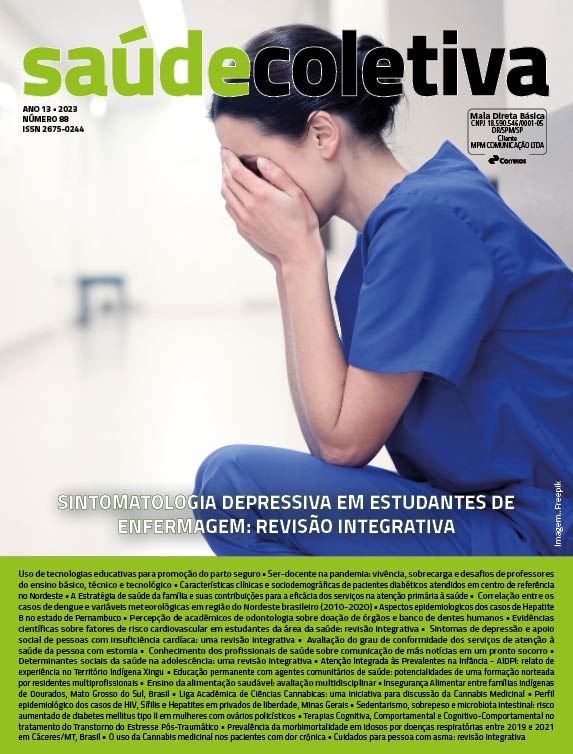O USO DA CANNABIS MEDICINAL NOS PACIENTES COM DOR CRÔNICA
DOI:
https://doi.org/10.36489/saudecoletiva.2023v13i88p13455-13475Palabras clave:
Cannabis medicinal; Dor crônica; TratamentoResumen
A dor crônica (DC) possui um impacto significativo na qualidade de vida (QV) da população. Ela repercute na capacidade funcional, podendo influenciar em maiores níveis de dependência, distúrbios do sono, alterações do humor e apetite. A descoberta do sistema endocanabinóide na dor demonstrou melhorar a QV de indivíduos com DC. Esse estudo busca analisar o uso da cannabis medicinal (CM) através da experiência terapêutica de pacientes diagnosticados com dor crônica, observando a interferência na dor, sono, humor e na QV e a ocorrência de efeitos colaterais (EC) Trata-se de um estudo observacional longitudinal, descritivo e prospectivo. A coleta foi realizada através de um formulário digital respondido no início do uso do canabinoide, após primeiro mês e no terceiro mês de uso. Os dados revelaram uma associação entre o uso da CM com a melhora da QV e uma deterioração significativa da dor, humor e do sono. Não houve EC significativos.
Citas
AGUIAR DP, et al. Prevalence of chronic pain in Brazil: systematic review. BrJP. 2021;(4):257-267.
DS KANEMATSU JAQUELINE, et al. Impacto da dor na qualidade de vida do paciente com dor crônica. Revista de Medicina. 2022;3:101.
COSTA ANE, NAPOLI AER. Revisão bibliográfica da abordagem do tratamento da dor crônica não oncológica, com base na escada analgésica da organização mundial de saúde. Brazilian Journal of Health Review. 2022 Aug 16;5(4):14365–81.
MATIAS, GF, et al. Uso de Cannabis para tratamento da dor crônica: uma revisão sistemática. Research, Society and Development. 2022;11(3).
NASCIMENTO DCH, SAKATA RK. Dependência de opioide em pacientes com dor crônica. Revista Dor. 2011 Jun;12(2):160–5.
CANNABIS MEDICINAL: Conselho Federal de Medicina vai na contramão do mundo [Internet]. Brazil Journal. 2022 [cited 2023 Oct 21]. Available from: https://braziljournal.com/cannabis-medicinal-conselho-federal-de-medicina-vai-na-contramao-do-mundo/
FINN DAVID P, et al. Cannabinoids, the endocannabinoid system, and pain: a review of preclinical studies. Pain. 2021;162:S5-S25.
CAMPOLINA AG, et al. Validação da versão brasileira do questionário genérico de qualidade de vida short-form 6 dimensions (SF-6D Brasil). Ciência & Saúde Coletiva. 2011 Jul;16(7):3103–10.
ESCALA VISUAL ANALÓGICA -EVA [Internet]. Available from: https://www.joinville.sc.gov.br/wp-content/uploads/2017/05/Exame-Escala-Visual-Anal%C3%B3gica-EVA.pdf
MAXWELL AE. Comparing the classification of subjects by two independent judges. British Journal of Psychiatry.1970;116:651–655.
STUART AA. Test for Homogeneity of the Marginal Distributions in a Two-Way Classification. Biometrika. 1955;42(3/4):412–416.
FRIEDMAN M. The Use of Ranks to Avoid the Assumption of Normality Implicit in the Analysis of Variance. Journal of the American Statistical Association. 1937;32(200):675.
CONOVER W, IMAN R. Multiple-comparisons procedures. Informal report. Los Alamos, NM (United States): [s.n.].
MANN HB, WHITNEY DR. On a Test of Whether one of Two Random Variables is Stochastically Larger than the Other. The Annals of Mathematical Statistics. 1947;18(1):50–60.
SHAPIRO SS, WILK MB. An Analysis of Variance Test for Normality (Complete Samples). Biometrika. 1965;52(3/4):591–611.
THE R CORE TEAM R. A Language and Environment for Statistical Computing. Vienna, Austria: R Foundation for Statistical Computing. 2023.
PORTER B, et al. Cannabidiol (CBD) use by older adults for acute and chronic pain. Journal of gerontological nursing. 2021;47(7):6-15.
SURAEV A, et al. Cannabidiol (CBD) and Δ9-tetrahydrocannabinol (THC) for chronic insomnia disorder (‘CANSLEEP’trial): protocol for a randomised, placebo-controlled, double-blinded, proof-of-concept trial. BMJ open. 2020;10(5):034421.
BLANTON HENRY L, et al. Sex differences and the endocannabinoid system in pain. Pharmacology Biochemistry and Behavior. 2021;202:173107.
RENSLO B, et al. Medical Cannabis Use Reduces Opioid Prescriptions in Patients With Osteoarthritis. Cureus. 2022;14(1).
MORENO-SANZ G, et al. Sex-Dependent Prescription Patterns and Clinical Outcomes Associated With the Use of Two Oral Cannabis Formulations in the Multimodal Management of Chronic Pain Patients in Colombia. Frontiers in Pain Research. 2022;(3).
URITS I, et al. Adverse effects of recreational and medical cannabis. Psychopharmacology bulletin. 2021;51(1):94.
BOEHNKE KEVIN F, et al. Cannabidiol (CBD) in Rheumatic Diseases (Musculoskeletal Pain). Current Rheumatology Reports. 2022;24(7): 238-246.
PETZKE F, et al. Cannabis-based medicines and medical cannabis for chronic neuropathic pain. CNS drugs. 2021;(1):14.
SOLMI M, et al. Balancing risks and benefits of cannabis use: umbrella review of meta-analyses of randomised controlled trials and observational studies. Bmj. 2023;382.
MILLS SEE, et al. Chronic pain: a review of its epidemiology and associated factors in population-based studies. British journal of anaesthesia. 2019;123(2):273-283.
SAUCH VALMANA G, Miró Catalina Q, Vidal-Alaball J. Prevalence and Incidence of Patients With Fibromyalgia in Catalonia Between 2010 and 2017: A Descriptive Observational Study. Journal of Primary Care & Community Health [Internet]. 2022 Jan 1 [cited 2022 Jun 29];13:21501319221094169. Available from: https://pubmed.ncbi.nlm.nih.gov/35465748/
HENDERSON LA, et al. American College of Rheumatology Clinical Guidance for Multisystem Inflammatory Syndrome in Children Associated With SARS–CoV‐2 and Hyperinflammation in Pediatric COVID‐19: Version 2. Arthritis & Rheumatology. 2021 Feb 15;73(4).
VILLANUEVA MRB, et al. Efficacy, safety, and regulation of cannabidiol on chronic pain: a systematic review. Cureus. 2022;14(7).
HENSON JD, Vitetta L, Hall S. Tetrahydrocannabinol and cannabidiol medicines for chronic pain and mental health conditions. Inflammopharmacology. 2022 aug [cited 2022 jul 7];30(4):1167-1178. Available from: http://www.ncbi.nlm.nih.gov/pubmed/35796920.
KAUL M, et al. Effects of cannabinoids on sleep and their therapeutic potential for sleep disorders. Neurotherapeutics. 2021;18(1):217-227.







